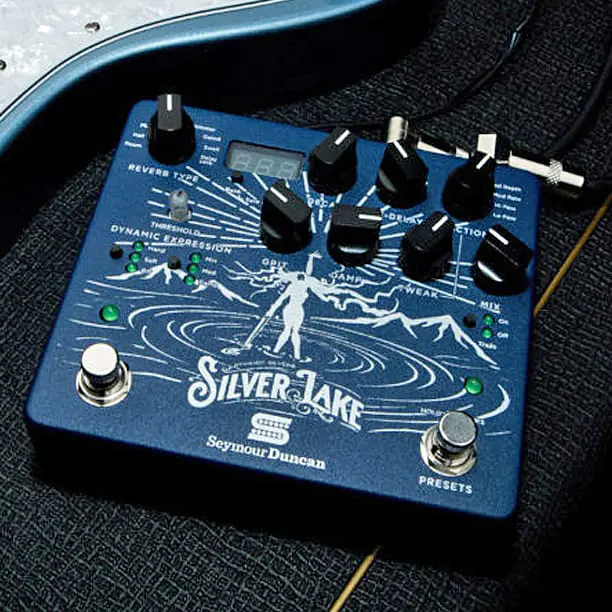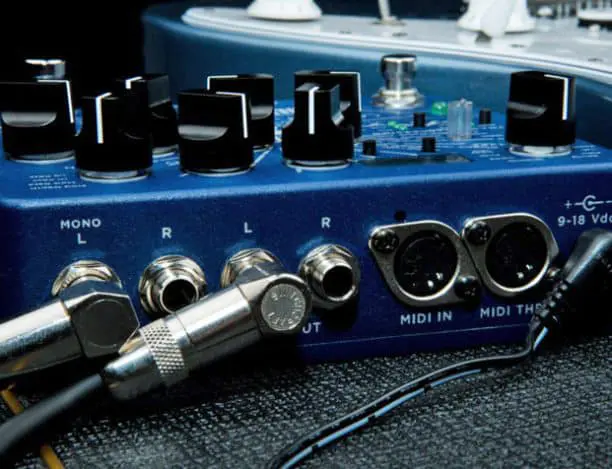
Seymour Duncan brought a new dimension to delay in 2017 with the Andromeda delay, a fully programmable digital workhorse packed with eight types of delay, echo and repeats. What made the Andromeda unique was its use of Dynamic Expression, Seymour Duncan’s proprietary feature that allows the pedal to respond to the player’s picking attack.
For 2018, the company has delivered the Andromeda’s ambient counterpart, the Silver Lake Dynamic Reverb, a pedal that offers eight reverb algorithms, a powerful set of tone-shaping options and—happily—the Dynamic Expression features that made such a difference to the Andromeda. Imagine being able to “play” your reverb pedal, picking softly to generate subtle ambience, then hitting the strings harder to produce massive soundscapes, modulation effects or tone-darkening damping. That’s the power of Dynamic Expression.
On Silver Lake, this responsiveness is mated to a pedal that provides room, spring, plate and hall reverbs, as well as shimmer, swell, gated and delay/verb effects, all produced in 24-bit/48kHz audio. Other features include a saturation-inducing Grit knob (more on this below), a Tweak control that lets you adjust modulation depth for chorus or vibrato on the reverberated signal, a Mix control to blend the dry and wet signals, and Lo Pass and Hi Pass filters to shape the ambiance’s tonal character. All those controls allow you to create sounds from the pedal’s front panel, without scrolling through menus or using an external programmer.

Silver Lake also has stereo inputs and outputs, MIDI In and Thru, 128 user presets and a micro-USB port that lets you connect it to Seymour Duncan’s Updater/Librarian software as well as download firmware updates, name and save presets to your computer and trade patches with others. And like all the company’s pedals, it’s designed and assembled at the Santa Barbara, California factory.
Judging by its feature set alone, Silver Lake is a remarkably deep pedal. We asked Kevin Harvey, Seymour Duncan’s U.S.A. Regional Accounts Manager, to take us for a plunge through its features.
Silver Lake is a versatile pedal with loads of reverb algorithms. What style of guitar player is it designed for?
When approaching the Silver Lake design, our goal was to create a reverb pedal that offered optimum tonal versatility and tweakability, and was also highly controllable, expressive and easy to use. I think we really hit the mark with Silver Lake in that regard.
As a result, Silver Lake is great for players of all styles–whether you’re a guy or gal looking for lush, in-your-face, angelic ambience or you’re looking to add a subtle three-dimensionality to your tone, Silver Lake is the reverb pedal for you.
Like the Andromeda digital delay, Silver Lake features Dynamic Expression. Tell us a bit about what this does.
Dynamic Expression is a feature that is unique to a few of the pedals in our assortment. It was first introduced on the Catalina Dynamic Chorus in 2016, and we have since incorporated it into the Andromeda Dynamic Delay and now the Silver Lake.
Dynamic Expression is a feature that allows the pedal to react to your playing in real time. In its simplest form, it allows a player to control the prevalence, or overall mix, of the effect through their pick attack—how hard or soft they play. In Soft mode on the Mix setting, the softer a player’s pick attack, the more prevalent or audible the reverb effect becomes. Conversely, in Hard mode, the harder a player’s pick attack, the more present the reverb becomes. This allows the player to control the amount of reverb they’re hearing in real time without the need for an external expression pedal. The reverb amount is literally at their fingertips.
On Silver Lake, you can also assign Dynamic Expression to control much more than just Mix. You can assign it to control the Mod (reverb modulation) or Damp (reverb dampening, which attenuates the reverb’s high end and alters the character of the reverb similar to how a carpeted vs. uncarpeted room would). This allows you to tap into tones that aren’t attainable anywhere else. A player can now control the depth of a reverb’s modulation or reverb dampening in real time simply by adjusting their pick attack.
Dynamic responsiveness has always been a desirable quality with amps and overdrive pedals. What was the thinking behind adding it to these effects?
Dynamic responsiveness is a quality that is inherent to gain and volume—it is a give-and-take relationship between the amplifier—or boost/overdrive/distortion pedal—and the player’s guitar signal. Therefore, volume and gain always react to a player’s touch in real time by nature, and that’s where their beauty lies. As an effect, they allow for maximum expression.
That dynamically responsive quality is something that all guitarists look for in some form or another when developing their gain structure and chasing tone. At Seymour Duncan, we thought, “Why can’t more effects be like that?” Thus, Dynamic Expression was born.
How have players responded to it?
The beauty of Dynamic Expression is that it can be as drastic or as subtle as you want it to be. I’ve seen players use Dynamic Expression on Silver Lake to dial in the most tame, subtle ducking reverb tones, but I’ve also heard folks craft some of the most electrifying, eccentric tones using Dynamic Expression that transformed the sound into something unlike any other guitar tone I had ever heard before. The feature offers something for all players and allows for totally new forms of experimentation. As a result, the response (no pun intended) has been really positive among players.
What does the Grit control do?
The Grit control on the Silver Lake is interesting and fun. As you turn the control up, it adds soft-clipping to the wet signal, meaning that it adds gain to the reverb trail only. This allows you to dial in these really hairy, industrial-sounding reverb tones. Combine that with Dynamic Expression, and you can tap into some almost synth-like sounds with your guitar. It’s really cool!
Guitarists are accustomed to seeing mono inputs on pedals, but Silver Lake, like the Andromeda, has stereo inputs. What are some of the advantages and applications for this?
When approaching our design for Silver Lake, we wanted to ensure that players had the maximum amount of tonal versatility and controllability at their disposal, and, with that, had maximum rig integration options as well. That is why we’ve included stereo inputs and stereo outputs on the Silver Lake, as well as full MIDI controllability.
We understood that most players tend to use time-based effects, like Delay and Reverb, at the end of their signal chain on their pedalboards. So with our Seymour Duncan time-based effects, like Silver Lake or our Andromeda Dynamic Delay, we wanted to design them to be compatible with any pedal that might be placed in front of them—mono or stereo—which is why we included both stereo inputs and outputs. So, if a stereo modulation pedal (like the Catalina Dynamic Chorus) is placed in front of the Andromeda Delay which is then placed in front of the Silver Lake in a signal chain, you can run all three pedals in stereo.
Do you anticipate offering new reverb algorithms in firmware updates, as other pedal makers have?
On both the Silver Lake Dynamic Reverb and the Andromeda Dynamic Delay, we have included a micro-USB input to allow players to connect both pedals to their computer to download future firmware updates, algorithms and expansions.
To learn more the Silver Lake Dynamic Reverb, visit Seymour Duncan and watch the video below.






















